The 12 Best 360Learning Alternatives for 2025

As your training program grows, so do your LMS needs. What worked for a small team may begin to feel restrictive. If you’re exploring what else is out there, this list of the 12 top 360Learning competitors will help you find a platform that matches your goals.
360Learning — a brief overview
360Learning is a cloud-based learning platform that combines traditional LMS features with collaborative learning tools. It’s designed to help companies upskill employees, customers, and partners by making it easy for internal experts to create and share training content.
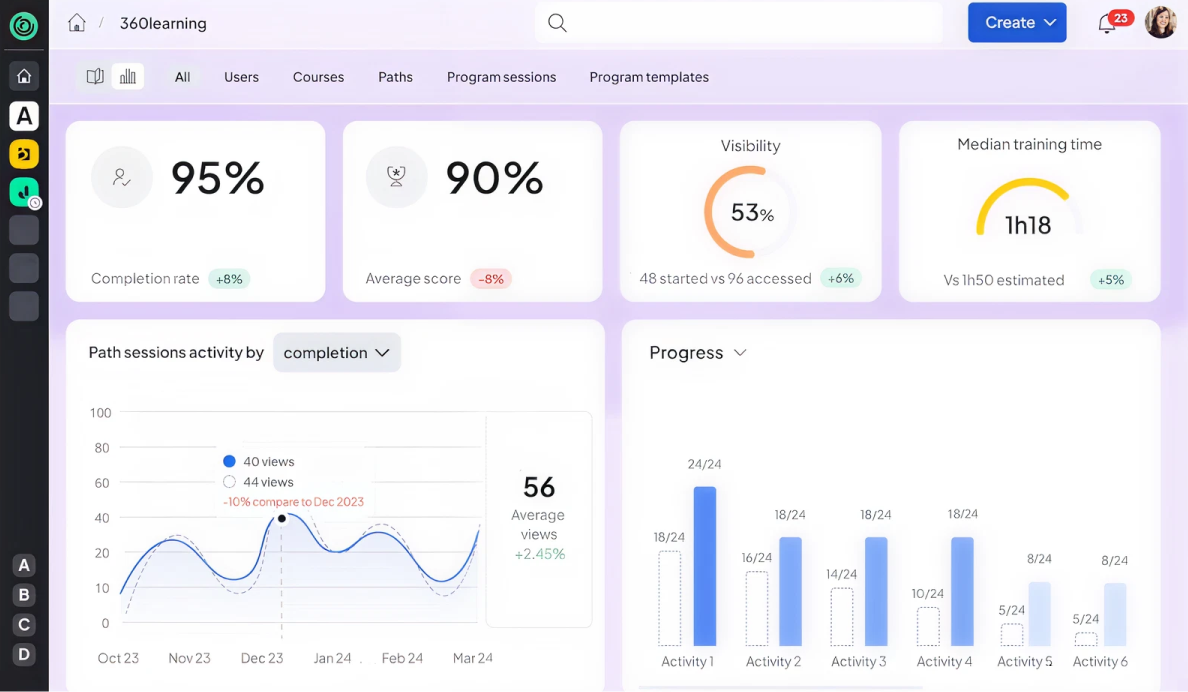
Instead of top-down course delivery, the platform focuses on peer learning, feedback, and team-driven knowledge sharing. Key features include:
- A course builder with support for video, text, quizzes, and assessments.
- Collaborative features like comments, reactions, and peer feedback threads.
- Learning paths and gamification tools.
- Integrations with HR systems and CRMs.
Why Look for an Alternative to 360Learning?
360Learning is known for its collaborative learning approach and works well for teams focused on peer-driven knowledge sharing. However, as training needs to evolve, some companies start to encounter limitations.
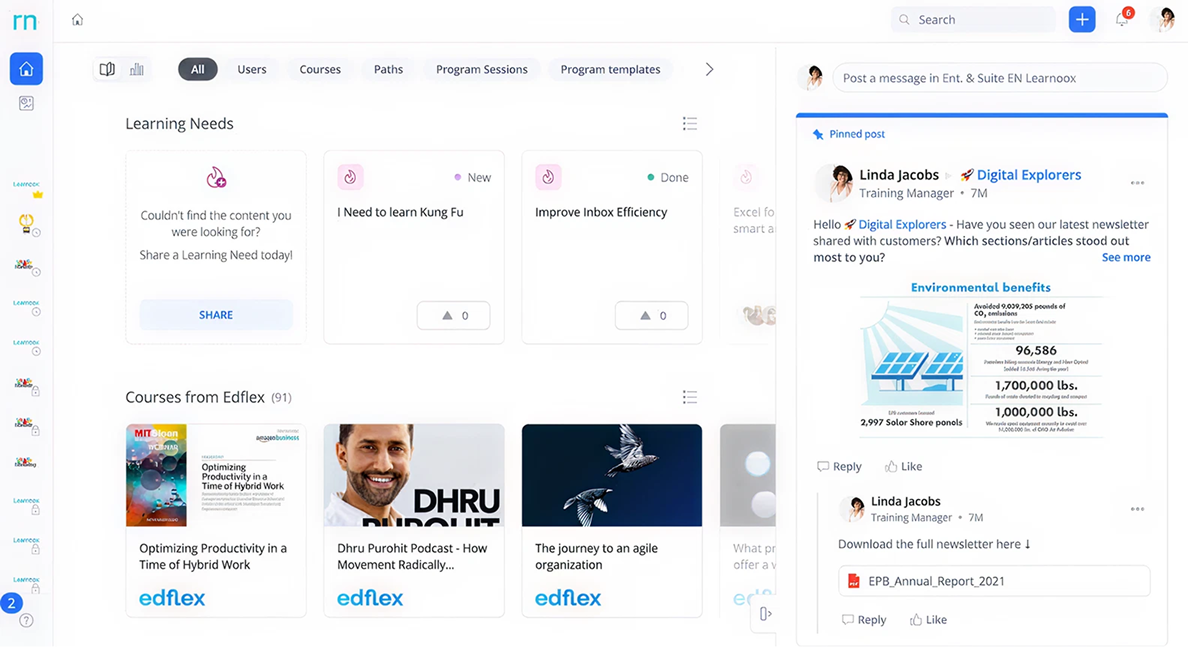
Based on user reviews from Capterra and G2, there are recurring concerns about missing features, limited flexibility, and added costs in higher usage tiers.
Pros
- Simple and fun to use for both admins and learners
- Helpful and proactive support team during setup
- Multiple support channels and responsive staff
- Fast course creation and smooth content sharing
Cons
- Quiz and exercise options can feel limited
- Gamification could be more developed for younger users
- Sometimes need to get creative due to limited ID resources
- Some limitations, but most issues could be resolved
360Learning pricing and hidden costs
The pricing looks simple at first, especially for small teams. But as you expand your training, key features like deeper branding, advanced integrations, or live session tools might only be available in higher-tier plans or require extra setup. The base plan offers good value, but scaling training programs often means upgrading for an extra fee.
“There are some features within 360 that are double-edged swords… If you assign an entire path, you lose the option to make sub-paths open at specific times.”
Lack of Course Management Tools
You can add a SCORM course to 360Learning and it’s quite easy to build basic training paths. However, its course management tools can feel limited for companies that need prerequisites, nested modules, or branching logic. The linear setup may not offer enough flexibility for complex training needs.
“There is no option to select submodules for learning… No proper backup option is available.”
Drawbacks in user experience and engagement
Still, with so many features, the interface can feel cluttered. Collaborative learning tools like shared feedback and discussion threads are useful but don’t always drive real engagement, especially in formal training settings where structure matters more.
“Due to there being lots of functionality, it’s quite confusing to use at first… The courses are simple and don’t really show how to do what you want.”
Reporting and customization limitations
Basic tracking is there, but reporting lacks depth. Some users mention that custom dashboards, advanced data filters, or detailed exports can be hard to configure or require extra effort to access. Branding options are limited too, which can be a drawback for teams that want more control over the look and feel of the learner experience.
“I think reporting could be better, although through workarounds I have been able to get what I need.”
What Are the Best 360Learning Competitors in 2025?
If 360Learning isn’t the right fit for your team, the good news is that there are plenty of solid LMS options out there. Below, we’ll walk through the twelve strongest 360Learning competitors, highlighting their strengths and things to keep in mind.
1. iSpring Learn
iSpring Learn is a well-rounded LMS that helps launch and manage employee training more easily. It supports everything from onboarding and compliance to performance reviews and internal comms — all in one place. With intuitive tools and automation, teams can save time, reduce training costs, and focus on skill development that drives business growth.
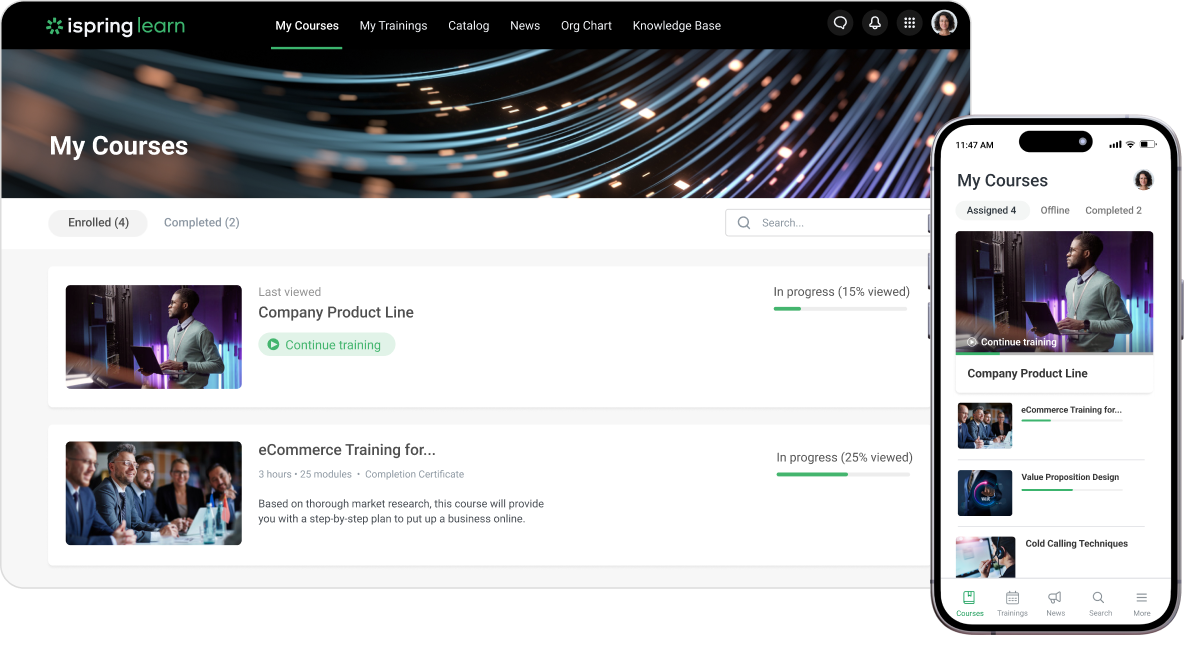
Key features
It’s a great fit for teams that want to blend structured eLearning with real-time training and performance tracking. Its features work well for both self-paced and instructor-led training:
- Learning tracks, automated enrollments, and reminders
- Supervisor dashboards and performance review tools
- Integrations with MS Teams, Zoom, and Salesforce
- iOS and Android mobile apps with offline access to learning
- Internal knowledge base
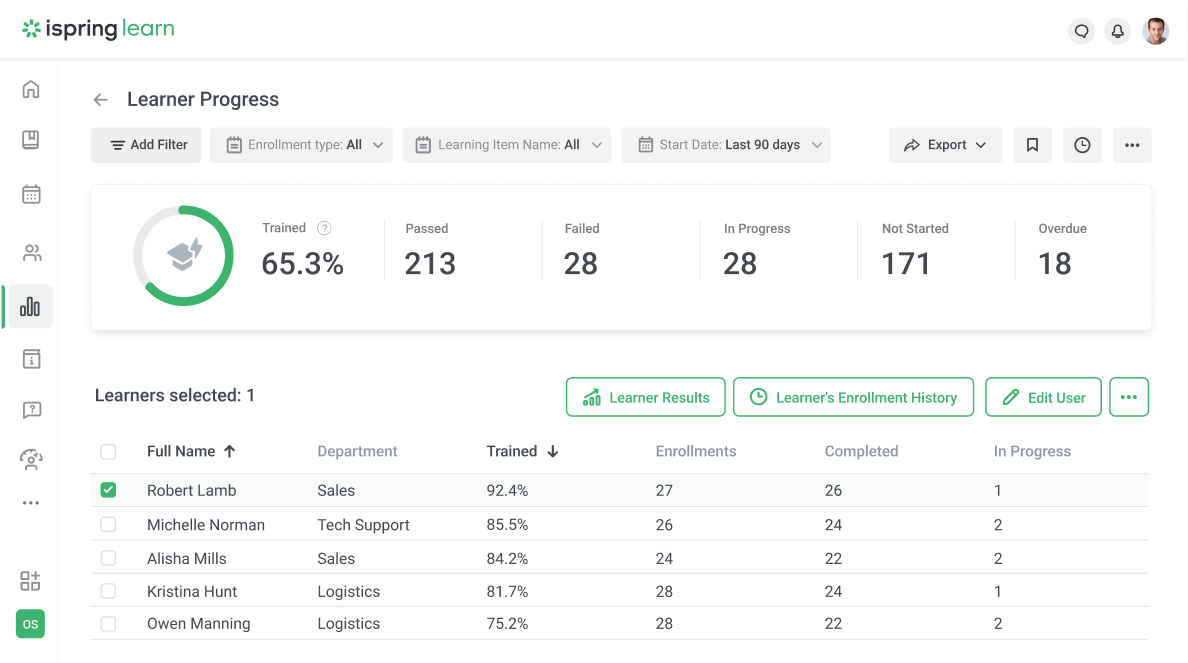
What users like
Users say the platform is easy to set up and works well for education and training needs, even without a full L&D team. It adapts to different training needs — from internal compliance to collaborative learning and customer education. The main highlights are:
- Simple interface for both admins and learners.
- Customized learning paths and real-time tracking.
- Mobile access with offline functionality.
- Strong implementation support and flexible use cases.
“We use iSpring not just for training, but also to track communication across the company. It’s simple to use and helps ensure no one misses important updates.”
What users dislike
Some users mention that while the platform is easy to navigate, features like group setup or quiz logic take some time to learn. Reviewers also note:
- Setup for groups and custom learning paths takes some practice.
- Reporting and automation could be more flexible.
- It lacks built-in tools for document signing or translation.
- Editing published courses can reset learner progress.
“The platform is very user-friendly, but I’d love more flexibility in custom notifications and reporting across learning paths.”
2. Absorb LMS
Absorb LMS is a cloud-based learning management system built for teams that need scalable training programs. It covers onboarding, compliance, skill-building, and external learning for customers or partners. Absorb is used by companies of all sizes, including universities and government agencies.
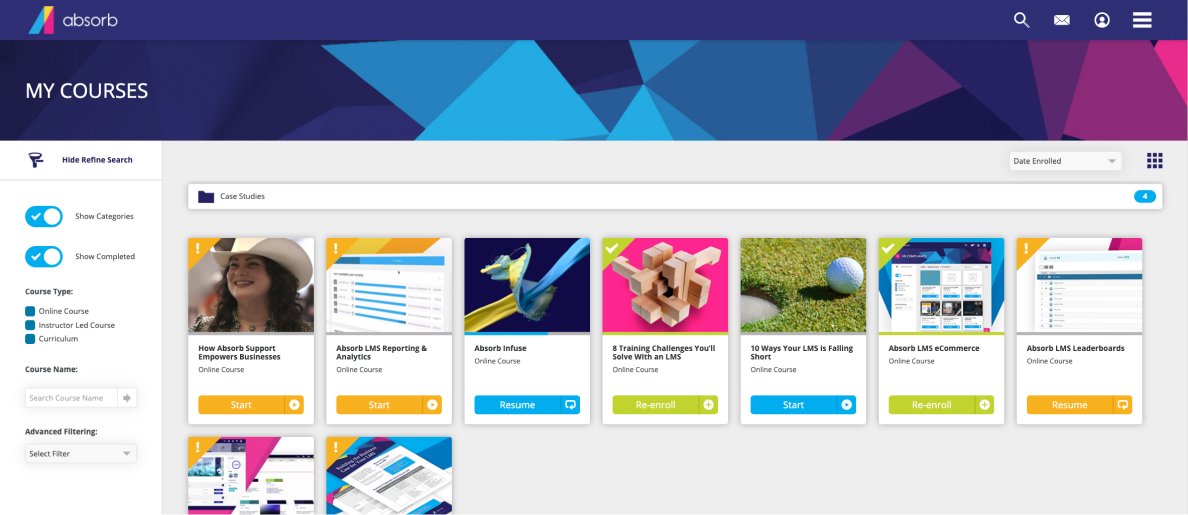
Key features
Absorb combines a clean interface with robust features, making it a good fit for both small teams and large organizations:
- Supports SCORM, xAPI, and multimedia content
- AI tools for course creation and advanced reporting (Absorb Analyze)
- Customized learning paths with role-based access control
- Integrations with Salesforce and HR systems
What users like
Users highlight Absorb’s clean design, strong performance, and support. Admins value its flexibility to tailor content and address skill gaps, while learners enjoy the smooth user experience:
- Simple, intuitive navigation for both admins and learners
- Customizable UI, templates, and impersonation for troubleshooting
- Built-in content via Absorb Amplify
- Responsive support and dedicated success managers
“Absorb gives a user interface that is simple to understand with a lot of customization…. Whenever I need help, there is always someone from Absorb who is knowledgeable and able to help answer any questions that I may have.”
What users dislike
Some users mention that advanced features take time to learn. Reporting is useful but lacks flexibility. Customization sometimes needs IT help or comes with plan limits:
- Steep learning curve for reports and automation
- Limited customization and visual setup options
- Reporting lacks filters and bulk actions
- Setting up custom learning paths needs IT support
“I have tried getting specific metrics such as timestamps in viewed courses and other important metrics that the Absorb Analyze reporting feature has not been able to produce.”
3. Docebo
Docebo is a cloud-based LMS built for enterprise learning. With AI, automation, and personalization, it works for both internal and external training — employees, customers, and partners. Setup takes time, but many choose Docebo as a long-term solution for complex, large-scale learning.

Key features
Docebo stands out for its scalability, customization, and collaborative learning support, which is important for global teams with diverse audiences:
- SCORM, xAPI, multimedia, and virtual classroom support
- Personalized learning paths with advanced analytics
- Smart Pages for branded portals
- API integrations (Salesforce, MS Teams)
What users like
Users like the flexibility to match diverse training needs once they get used to the platform. They mention:
- Modern UI and intuitive admin tools
- Deep branding options and Smart Pages
- Time-saving AI-driven automation
- Helpful community, documentation, and support
“We ultimately chose Docebo because of its strong set of capabilities, flexibility, vibrant user community, and ease of use for administrators and users… We have always found a way to accomplish our goals.”
What users dislike
While Docebo offers a lot of flexibility, some features take time to master and may require extra support:
- Certification and permission tools lack depth or clarity
- Interface feels inconsistent across sections
- Complex setups often need technical help
- Some add-ons cost extra, and support can be slow
“Their internal team is difficult to reach and can take weeks and be very costly to support the platform…. The premium partners are great, although for direct technical support, it’s difficult to get easy help.”
4. Cornerstone OnDemand
Cornerstone OnDemand is a long-standing enterprise learning management system that’s part of a complete talent management suite. Companies use it to deliver online compliance, upskilling, and onboarding courses for long-term growth across global teams.
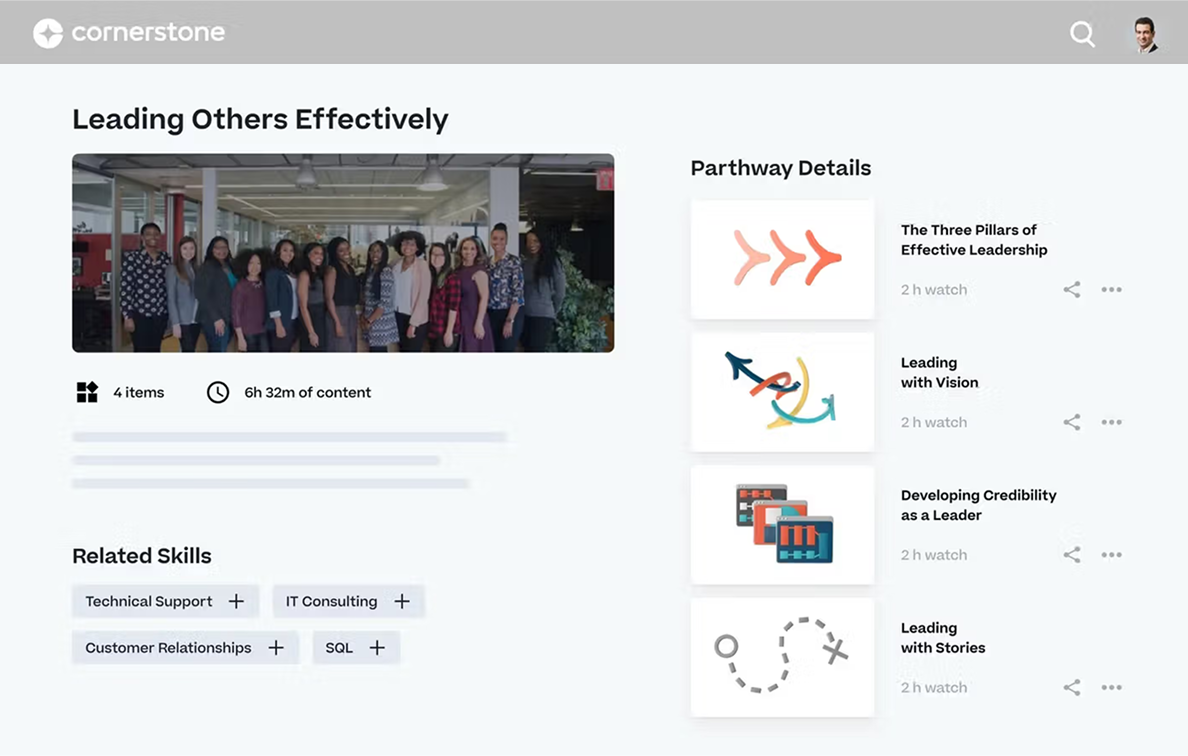
Key features
Cornerstone is best suited for large companies that need strong features and tight HR integration:
- Customizable learning paths and AI-powered recommendations
- SCORM, video, and interactive content support
- Built-in course marketplace and multilingual delivery
- Deep HR integrations (Workday, SAP) with analytics and reporting tools
What users like
Users appreciate how powerful and configurable the platform is, especially for large-scale learning and talent strategies:
- Personalized learning paths and roles
- Bulk actions and automation save admin time
- Extensive integrations and content library
- Active user community and solid documentation
“The functionality is comprehensive, with a lot of features you can customize, including custom pages, which are great for improving the user experience.”
What users dislike
While Cornerstone offers flexibility, it can feel overwhelming — especially during setup or when switching between older and newer modules:
- Mixed legacy and modern UI can be confusing
- Customization often requires heavy admin work
- Reporting is powerful but not user-friendly
- Updates and support responses may be slow or inconsistent
“There are still a lot of functionalities that one would think would be a given with an LMS that, despite feedback, they choose to focus on their bigger scale feature releases.”
5. Litmos
Litmos is a cloud-based LMS known for its quick setup and ease of use. It’s popular in industries like healthcare, retail, and finance for onboarding, compliance, and ongoing training. Its clean interface and quick deployment help teams launch training programs with minimal hassle.
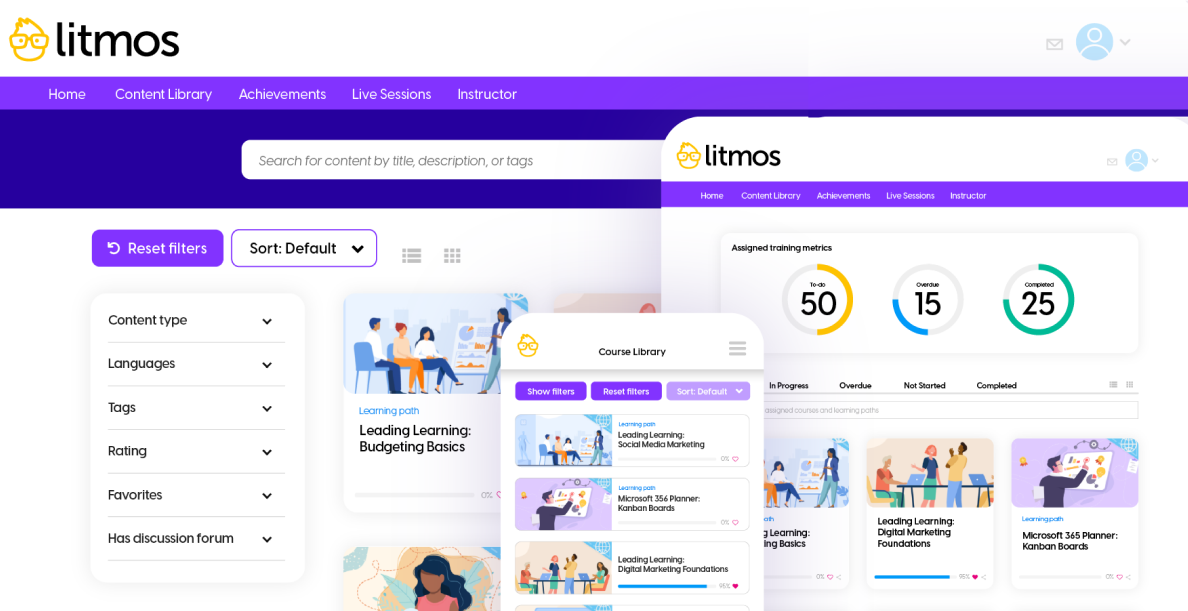
Key features
Litmos works well for companies that want a simple, scalable system without a heavy admin load:
- Built-in authoring and microlearning support
- SCORM, video, and gamification support
- Automated course assignments and user segmentation
- Access to pre-built online courses in Litmos Library
What users like
Users like how easy it is for both admins and learners to work with. It’s quick to set up and the mobile app runs smoothly for frontline teams:
- Clean, intuitive interface with fast setup
- Simple for both admins and learners
- Handy built-in tools for content and gamification
- Attentive customer support and success managers
“The CAT provides an intuitive way to create, edit, and publish courses all within the platform itself. It is a time-saver for content developers and instructional designers!”
What users dislike
Despite its strengths, Litmos has a few weak spots, especially when it comes to flexibility and more extensive customization:
- Limited customization and rigid reporting
- Mobile app can be buggy on some devices
- Permissions and team logic feel complex
- Support quality varies between reps
“User permissions are cumbersome…. What a specific person in a team can see/do compared to others is hard to manage.”
6. ProProfs
ProProfs Training Maker is a lightweight LMS made for speed and simplicity. It works best for small businesses, educators, and teams that want to launch training or quizzes fast without dealing with complex setup.
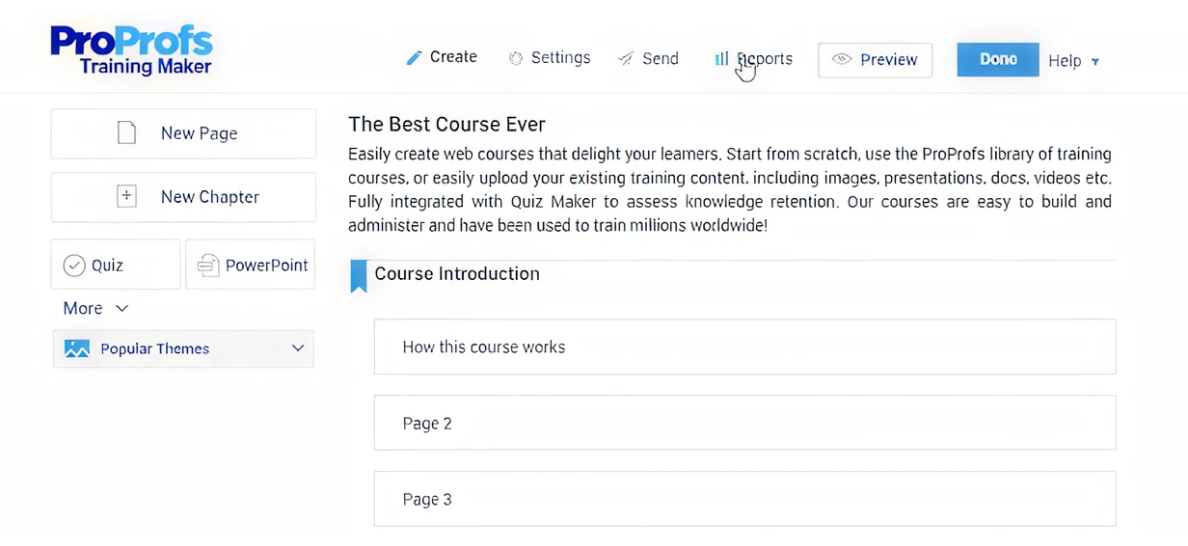
Key features
It doesn’t offer deep enterprise tools, but it covers the basics well for onboarding, compliance, and quick training needs:
- Drag-and-drop builder with SCORM, video, and quizzes
- Certification tracking and automated email reminders
- Learner management by group or location
- Supports 70+ languages and includes virtual classrooms
What users like
Users value the simple setup and easy-to-use tools — especially those for quizzes, compliance, and basic training:
- Very intuitive with a short learning curve
- Strong for quizzes, certifications, and basic tracking
- Mobile-friendly and multi-language support
- Affordable option for smaller organizations
“It has become an indispensable tool for our onboarding process. We can also onboard multiple new hires simultaneously without additional resources.”
What users dislike
The platform has its limits for teams that need more extensive customization or advanced course management workflows:
- Limited customization and dated UI in places
- Lacks support for complex course structures
- Reporting and automation are fairly basic
- Support and documentation can be inconsistent
“The instructions or options for branding and templates are too rigid…. Some advanced automation tools take too much time to configure.”
7. LearnUpon
LearnUpon is built for corporate training across employees, customers, and partners. Its key strength is multi-portal support — each portal can have unique branding, content, and users that are all managed from one place.
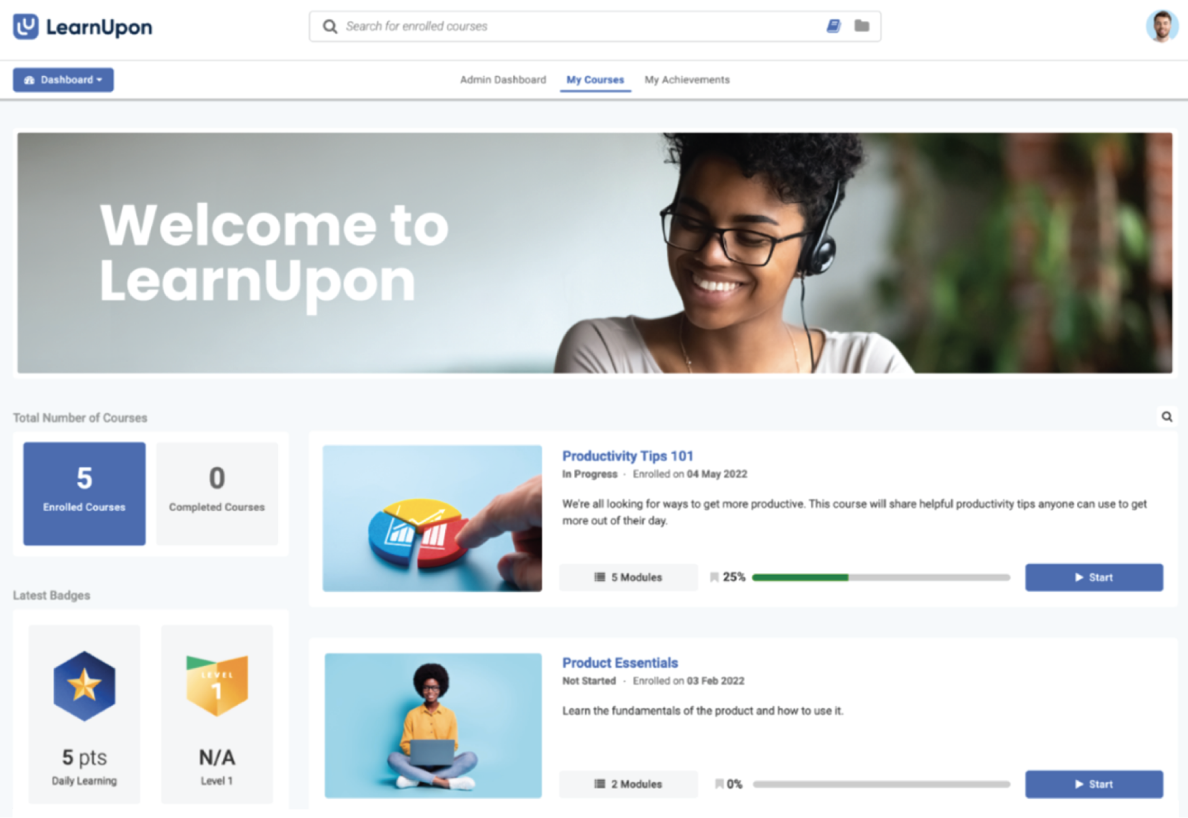
Key features
LearnUpon focuses on speed, structure, and scale, with a user-friendly experience for both admins and learners:
- Multi-portal setup with custom branding and centralized controls
- Course creation with quizzes and certifications
- SCORM/xAPI support and integrations (Salesforce, Zoom, HR tools)
- Mobile-friendly access
What users like
Users mention how quick and easy it is to set up. The ability to manage multiple audiences in a single system is a major plus. Users highlight:
- Quick setup and a smooth, intuitive UI
- Works well for different audiences under one roof
- Solid automation and third-party integrations
- Support team is responsive and helpful
“We went from no LMS to full rollout in weeks. Their support across every step — from sales to launch — was incredible.”
What users dislike
Even with its strengths, LearnUpon has some rough edges:
- Limited customization for UI and course layout
- Manual setup steps and a developing path logic
- Reporting lacks depth for advanced tracking
- Some tasks require direct support to configure
“Setting up one course can be time-consuming, and old versions clutter the backend. It’s clean for users, but clunky for admins.”
8. Bridge
Bridge is an employee training and development platform designed to support performance reviews, skill tracking, and goal setting. It’s a good fit for companies that see learning as part of a broader talent strategy, not just a standalone activity.
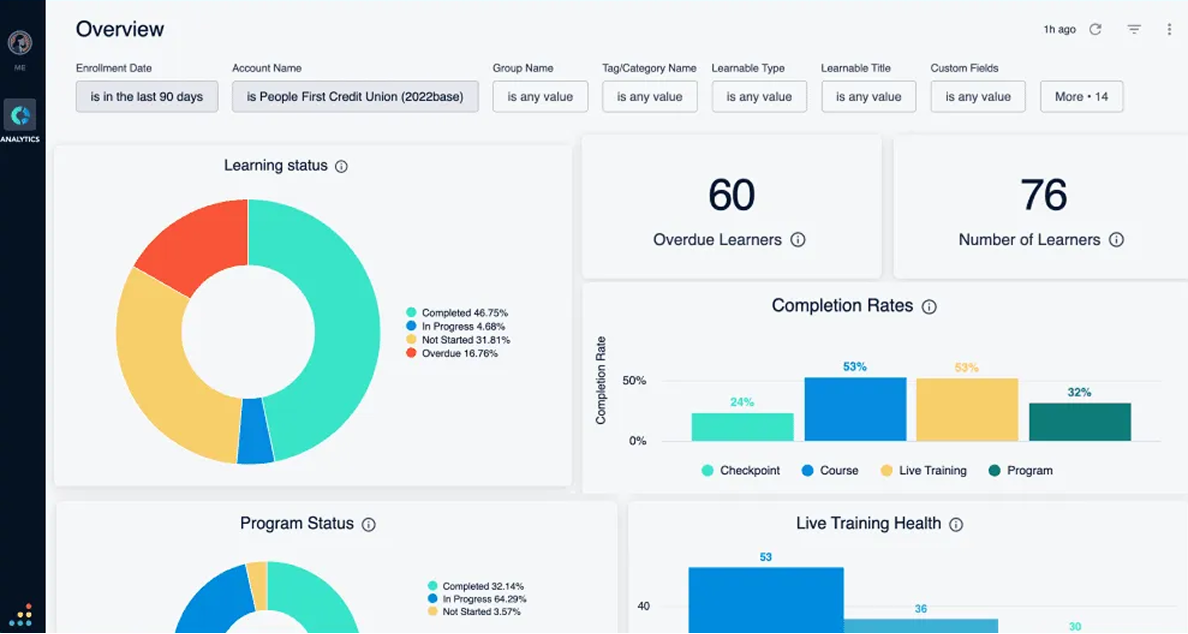
Key features
Bridge focuses on long-term development, making it a solid choice for HR and L&D teams:
- Built-in course creator
- Tools for performance reviews, goals, and 1:1 planning
- Mobile learning with offline access
- Supports external users and integrates with Google Meet, OpenSesame
What users like
Users enjoy having training and performance tools in one place:
- Clean, intuitive UI and smooth navigation
- Combines learning with performance management
- Great mobile app for remote learners
- Solid support and a helpful live chat
“The more I use Bridge, the more I like it. Courses, programs, and journeys are easy to build. It’s becoming a one-stop shop for employee training.”
What users dislike
Bridge isn’t ideal for teams that need extensive customization or advanced features. Some users report bugs and limitations in reporting, content display, and branding:
- Limited customization and branding flexibility
- Reporting lacks filters and advanced dashboards
- No SCORM 2004 support; content display issues (PDF, SCORM)
- Some friction with calendar tools and live session setup
“Bridge was clean and simple but lacked the reporting depth and custom roles we needed. We moved to Docebo — but miss some of Bridge’s ease of use.”
9. Tovuti LMS
Tovuti is a cloud-based learning management system focused on visual interactivity and learner engagement. It’s used for both internal and external training, which helps teams build immersive learning experiences that engage learners.

Key features
Tovuti packs a lot of features, but smaller teams may face an imposing learning curve:
- 40+ content types with built-in gamification
- AI assistant
- Custom branding and white-label portals
- eCommerce tools and integration with Salesforce
What users like
Users love how easy it is to build fun, interactive content without additional tools. Support gets high marks too, especially during onboarding:
- Interactive content and gamification help engage learners
- Flexible design and custom branding
- Responsive support during onboarding
- Scales well for internal and external teams
“Tovuti lets us build a fully customized, branded experience with engaging content — our learners love it.”
What users dislike
Some teams find the platform a bit complex at first. Reporting needs work, and media-heavy content can slow things down:
- Steep learning curve and limited help center depth
- Reporting lacks the flexibility that allows deeper insights
- Occasional lag with video or large datasets
- Some areas offer limited visual customization
“Tovuti is powerful but not always intuitive. We needed extra support to get started — and we wish the reporting was more flexible.”
10. Seismic Learning
Seismic Learning, formerly known as Lessonly, is a training platform tailored to fast-paced, customer-facing teams. As part of the broader Seismic suite, it focuses on sales enablement, onboarding, and ongoing coaching instead of traditional eLearning.
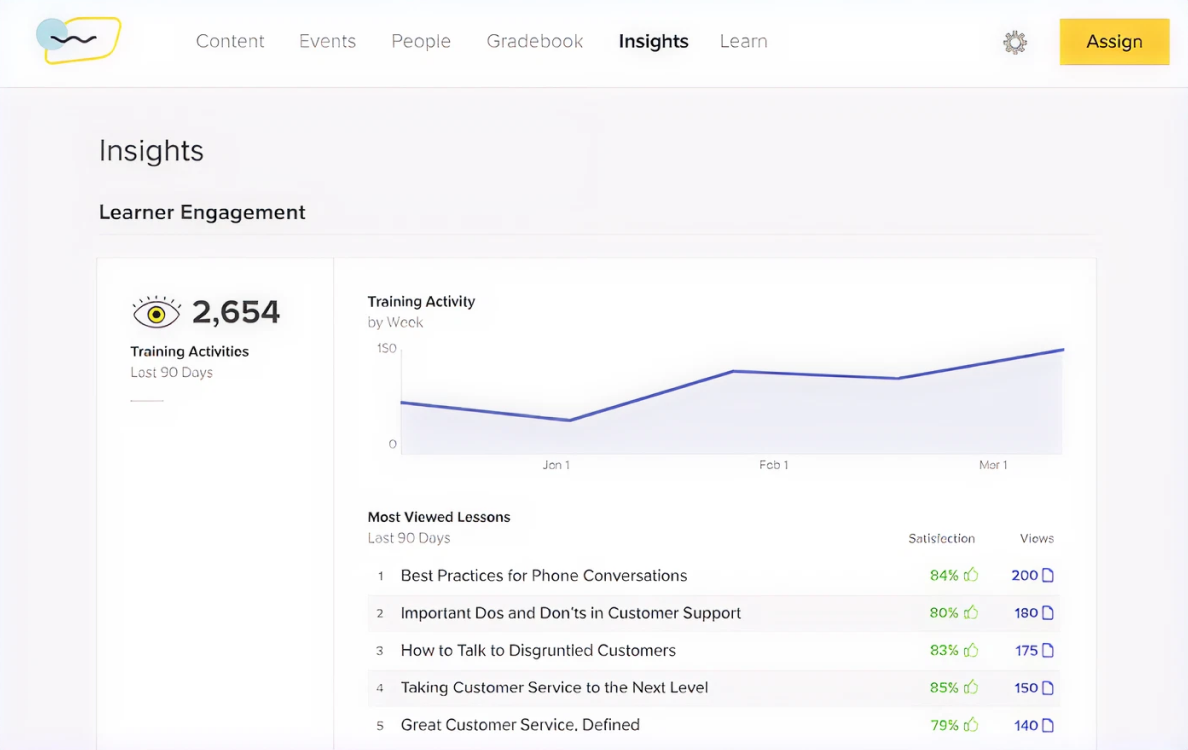
Key features
Designed for practical training, Seismic Learning emphasizes coaching and real-world skill application:
- Bite-sized lessons with support for text and multimedia
- Built-in tools for video practice, coaching, and feedback
- Task tracking and reusable curriculum options
- Integrates with other Seismic tools
What users like
Users appreciate how fast and simple it is to build training with practice tools like video feedback:
- Easy to create, assign, and update lessons
- Strong focus on coaching and skill-building
- Intuitive UI for admins and learners
- Helpful support and seamless integration with Seismic
“Seismic Learning is our go-to for onboarding and enablement — it’s simple to use, and the coaching features really improve performance.”
What users dislike
While being great for enablement, it lacks some core LMS features like:
- No SCORM/xAPI support; limited lesson customization
- Analytics and reporting tools are basic
- Occasional glitches or performance issues
- Not ideal for complex paths or certification programs
“It’s a great tool for enablement, but too simple for structured academic or compliance-heavy programs.”
11. Sana Labs
Sana is a modern learning platform with AI at its core. It helps teams automate content delivery, optimize course creation, and centralize internal knowledge — making it a great fit for fast-moving companies that want scalable training.
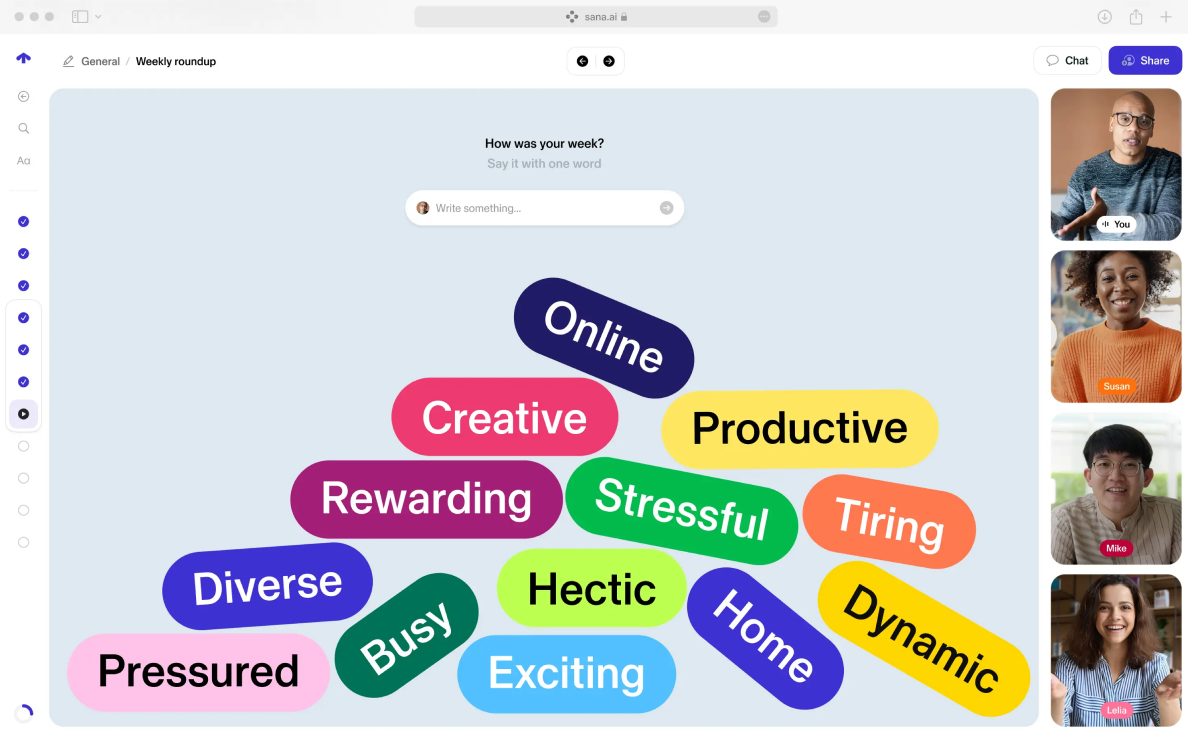
Key features
Sana works as both an LMS and an internal knowledge base:
- AI creation of lessons, quizzes, and flashcards
- Smart search, multilingual support, and live collaboration tools
- Supports video, audio, text, and infographics
- Integrates with MS Teams and HRIS tools
What users like
Users love the AI tools and how easy it is for SMEs to build training even with no L&D background:
- Fast AI-driven content creation and intuitive UX
- Strong search and discovery for just-in-time learning
- Easy for both admins and subject-matter experts
- Supportive, collaborative vendor team
“The AI features and intuitive UX are game-changers. Our SMEs built complete programs within weeks — with no prior experience in L&D.”
What users dislike
Being a newer platform, Sana still has some rough edges, mainly regarding design flexibility and depth of reporting:
- Limited formatting and layout options in the course builder
- Basic reporting and restricted API integrations
- Occasional performance issues
- Some workflows require refinement and better documentation
“Sana is sleek and modern, but some workflows — especially reporting and assignment — need polishing.”
12. WorkRamp
WorkRamp is a flexible LMS designed for employee training and customer education. It lets teams manage onboarding, enablement, and external education without switching between multiple tools.
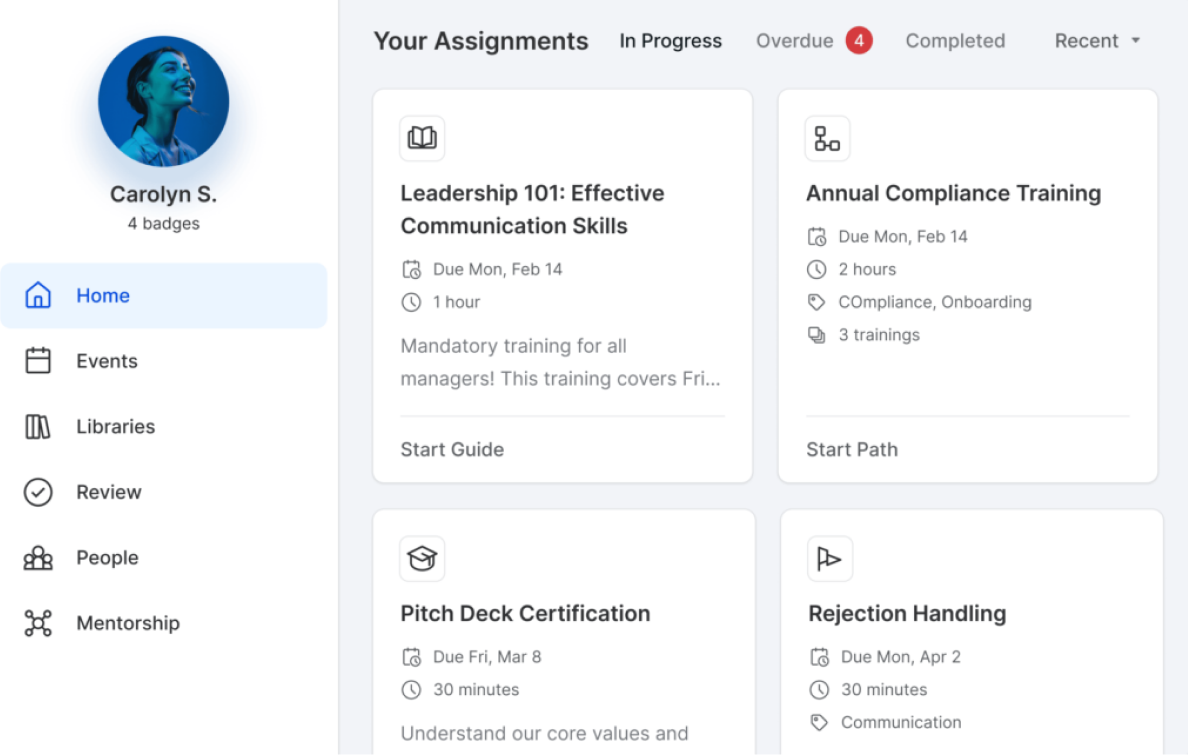
Key features
Being popular with mid-market and enterprise teams, WorkRamp combines scalability with ease of use:
- Modular builder for text, video, quizzes, and assignments
- Separate portals for internal and external training (ELC & CLC)
- Custom paths, certifications, automation, and coaching tools
- Integrations with major platforms and basic SCORM support
What users like
Users say it’s easy to build and manage content. They also highlight the quick setup and responsive support.
- Intuitive UI for admins and learners
- Fast setup and flexible content creation
- Works well even for small teams
- Great support and strong integration options
“I implemented WorkRamp solo as a one-person team. The platform is intuitive, and the support I got was incredible.”
What users dislike
Some users find that it lacks advanced features found in more specialized LMSs, such as personalized learning paths or extensive reporting. Automation and reporting are limited, and customization options are fairly basic:
- Limited flexibility in reporting and automation
- Basic customization and UI quirks
- Separate admin views for each portal
- No xAPI; SCORM support can be inconsistent
“Reporting is easy to use — but not very flexible. We’d like to see more options, especially across portals.”
What Is the Best 360Learning Alternative for You?
Before you decide, here’s a quick side-by-side recap to help you compare 360Learning alternatives at a glance. This quick comparison covers each platform’s focus, strengths, common limitations, and starting price so you can find the one that fits your team best.
| LMS | Short Description | Pricing |
| iSpring Learn | User-friendly LMS for fast, structured training at scale. Great for blended learning and internal comms. Some advanced automation needs mastering. | Starts at $3.70 per user/month |
| Absorb LMS | Scalable LMS with strong automation and reporting; great for growth. Can seem pricey or complex at scale. | Available upon request |
| Docebo | AI-powered LMS built for enterprise flexibility. Setup takes time, and advanced features may need extra support. | Available upon request |
| Cornerstone | Robust system for large companies connecting L&D with HR. Complex UI and setup may slow teams down. | Available upon request |
| Litmos | Easy-to-use LMS with fast setup and built-in content. Customization and reporting are limited. | Available upon request |
| ProProfs | Simple tool for quizzes and onboarding. Great for SMBs, but lacks depth for complex training. | Starts at $2.99 per active learner/month |
| LearnUpon | Multi-portal LMS for customer and employee training. Easy to scale, but customization and reporting can be limited. | Available upon request |
| Bridge | Combines learning with performance tools. Great for L&D and HR teams. Reporting and SCORM support are limited. | Available upon request |
| Tovuti | Highly interactive LMS with strong design tools. Can be overwhelming for small teams or new admins to learn. | Available upon request |
| Seismic Learning | Enablement-focused platform with strong coaching tools. Too lightweight for formal or compliance-heavy training. | Available upon request |
| Sana | AI-driven LMS for fast content creation and knowledge sharing. Still maturing; some features feel raw. | $13 per license, minimum 300 licenses |
| WorkRamp | Scalable LMS for employee and customer training. Easy to use, but lacks advanced LMS features, like xAPI and deep reporting. | Available upon request |
Conclusion
Choosing the right LMS takes time, but there are plenty of good options to explore. Focus on what matters most to your team, test-drive a few tools, and see what feels right.
If you want a solution that’s easy to launch, flexible, and built for structured training, check out the iSpring Learn LMS. Book a free demo to see how iSpring Learn supports your training goals.







